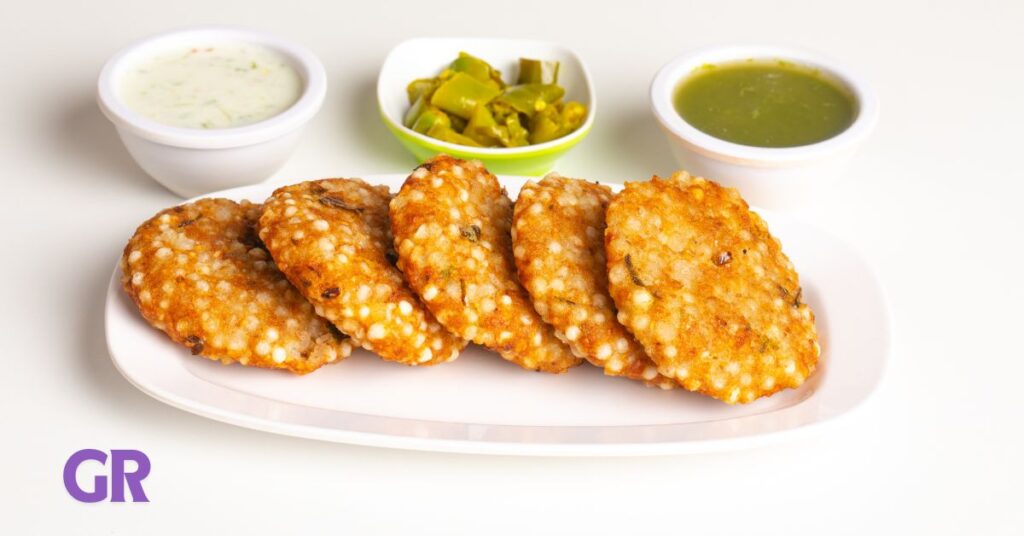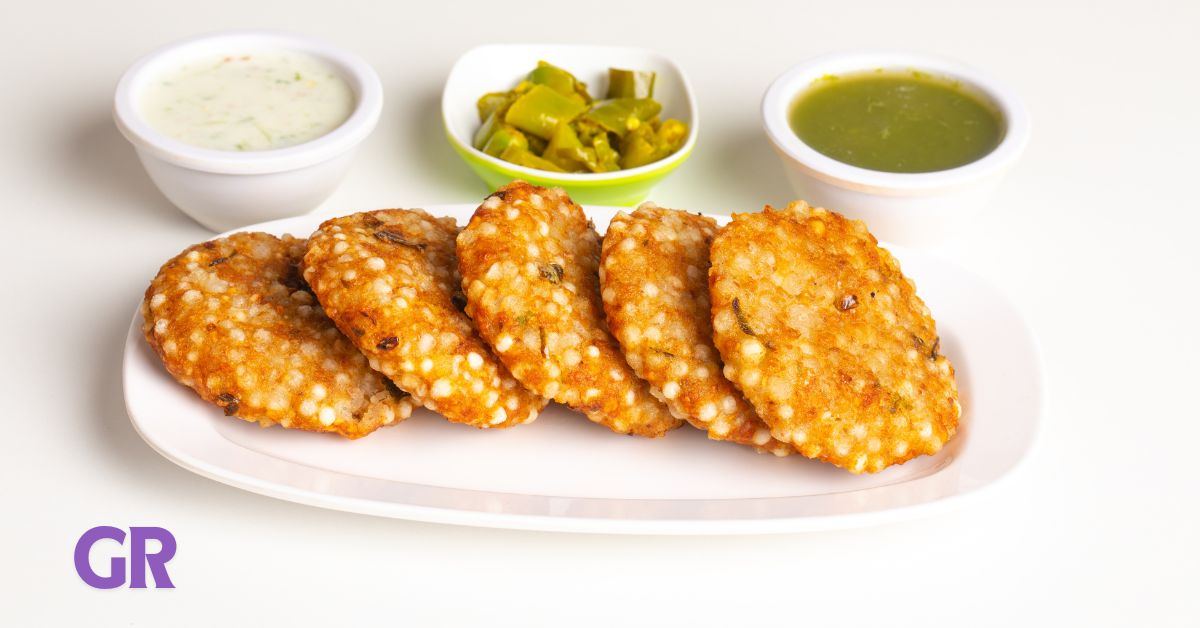Welcome to our blog Gujarati Rotlo Food Recipes. In this article, we will be learning Farali Sabudana Cutlet Recipe in Gujarati and how to make this delicious Sabudana Tikki Recipe in just 15 minutes. You can serve ફરાળી કટલેસ to your friends, family, and loved ones.
About Gujrati Rotlo Food Recipes
Before we move ahead with the recipe, let us share some information about our blog Gujrati Rotlo (ગુજરતી રોટલો) Food Recipes with you all. We started our food channel in September 2022, with a simple vision of letting every individual prepare their own food without being dependent on a house help, chef, or homemaker.
Farali Sabudana Cutlet Recipe is a delightful snack made with tapioca pearls, mashed potatoes, and spices. This crispy and delicious snack is perfect for Hindu fasting days like Ekadashi, Navratri, Mahashivratri, or Chaturthi. It’s easy to customize with ingredients allowed during fasting. This recipe is similar to sabudana vada but with a different shape. Enjoy these cutlets with green coriander chutney or tomato sauce and a hot cup of tea.

What is Sabudana CUTLET recipe?
A classic Maharashtrian food, sabudana cutlet consists of deep-fried, crisp-and-golden patties made of mashed potatoes, roasted peanuts, soaked tapioca pearls, spices, and herbs. Depending on the area, a variety of foods, including lentils, some spices, garlic, and onions, are avoided during the fasting days.
A very famous faraal food from the maharashtrian repertoire, the Maharashtrian style sabudana vada can either be relished as a quick snack or as a whole meal along with curd! Sabudana vada for Navratri is a signature dish for not only during Navratri, but during most festivals when people fast. It is also a memorable experience as it is enjoyed by many during the monsoon. You can also try other sabudana recipe like sabudana khichdi.
The potatoes and peanuts both act as binding agents, while also lending the crispy texture to these Gujarati farali sabudana vada. We have not used coriander to make these vadas, as many of us do not consider it in the list of upvas foods. However, if you eat, you can add it.
Consequently, none of these ingredients are used in the preparation of fasting foods like this sabudana cutlet .As sabudana is just starch, the addition of peanuts provides some nutrients. All of these are connected via potatoes. This recipe is guaranteed to produce crispy and delicious sabudana vada that absorbs less oil. Please read through all of my advice if you’re new and make these
Regular spices, batata, and sabudana are used to make farali cutlets. During vrat (Hindu fast) days like mahashivratri, navratri, ekadashi, and other upvas, this lightly spiced cutlet with farali chutney will definitely satisfy your desires because it is crispy on the exterior and soft on the inside.
I use raw sabudana powder in this recipe to help give the cutlet a binding and crunchy flavor. It is a very easy meal that appeals to all age groups. Please give this a try!
Ingredients for farali Sabudana Cutlet Recipe
For Green Coriander Chutney:
- Coriander Leaf – 100 gms
- Lemon – 1 pc
- Salt – 1/2 tsp
- Groundnut seed – 4 tsp
- Sugar – 1 tsp
- Water – 30 ml
- Green chilly – 3 pcs
For Sabudana Cutlet:
- Soaked Sabudana – 500 gms
- Boiled Potatoes – 500 gms
- Cumin seed – 2 tsp
- Lemon – 1 pc
- Salt – 2 tsp
- Coriander leaf – Few
- Sugar – 2 tsp
- Black Pepper – 2 tsp
- Roasted Peanut powder – 300 gms
- Green chilly & Ginger paste – 2 tsp
Recipe Video: farali Sabudana Cutlet Recipe
Instructions for Green Coriander Chutney
- In a mixture jar, add groundnut seed, green chilly, cumin seed, salt, sugar, and lemon juice. Grind to a fine smooth paste.
- Add coriander leaf and water to the mixture jar and grind to a smooth thin green chutney.
- Remove the chutney in a bowl and serve with hot Farali Sabudana Cutlet.
Instructions for Farali Sabudana cutlet recipe in gujarati
- Grate the boiled potatoes in a plate for better texture than mashed potatoes.
- Add soaked sabudana (soaked 8 hours prior) to the grated potatoes.
- Add roasted peanut powder (not too fine), cumin seed, salt, sugar, black pepper powder, lemon juice, and coriander leaf.
- Mix all ingredients gently to prepare the Sabudana Cutlet stuffing.
- Grease your palm with oil, take a medium amount of mixture, make round balls, and shape them using a heart-shaped mould.
- Let the cutlets rest for 10-15 minutes for a crispy texture.
- Heat oil in a pan on medium flame for deep frying.
- Check if the oil is ready by adding a small amount of stuffing.
- Fry 3-4 cutlets at a time until golden brown, turning them to cook evenly.
- Serve hot with green chutney or tomato sauce.
Conclusion: Sabudana Cutlet Recipe
Farali Sabudana Cutlet Recipe is a North Indian style recipe and Sabudana Vada is a delicacy from the Maharashtrian cuisine. Moreover Sabudana Vada are deep fried and these Farali Sabudana Cutlet are pan-fried with a few tablespoons of oil. Even thought the preparation of Farali Sabudana Cutlet Recipe looks similar to that of Sabudana Vada, some of the ingredients included in the Cutlets or Tikki are unique and different.
Unlike a sabudana vada which has a good amount of peanuts, Sabudana Tikki Or Farali Sabudana Cutlet Recipe has a few cashews and raisins added to it. Dry mango powder is added here instead of lemon juice to give a slight tang to the patties.
For more delicious recipes like Farali Sabudana cutlet recipe in gujarati, Gujarati Recipes, and Sabudana Tikki Recipe, regularly visit our blog “Gujrati Rotlo Food recipes”.
FAQ: Farali Sabudana cutlet recipe in gujarati
1. What are Farali Sabudana Cutlet recipe?
Farali Sabudana Cutlet Recipe are a popular Indian snack made from sago pearls (sabudana), potatoes, and spices. They are typically enjoyed during fasting periods (vrat) like Navratri, Ekadashi, and other Hindu festivals1.
2. What ingredients are needed for Farali Sabudana Cutlet recipe?
- Sabudana (sago pearls)
- Potatoes (boiled and mashed)
- Crushed peanuts
- Green chili paste
- Salt
- Black pepper powder
- Cumin powder
- Sugar
- Lemon juice
- Fresh coriander leaves
- Oil for frying1
3. How do you prepare Farali Sabudana Cutlets?
- Soak Sabudana: Soak sabudana in water for a few hours until they become soft.
- Prepare Mixture: In a mixing bowl, combine soaked sabudana, mashed potatoes, crushed peanuts, green chili paste, salt, black pepper powder, cumin powder, sugar, lemon juice, and fresh coriander leaves.
- Shape Cutlets: Grease your hands with oil and shape the mixture into round or heart-shaped cutlets.
- Fry Cutlets: Heat oil in a pan and fry the cutlets on medium heat until they are golden brown and crispy on both sides.
- Serve: Serve hot with farali chutney1.
4. Can I use any other binding agent instead of potatoes?
Yes, you can use sweet potatoes or raw bananas as a binding agent if you prefer1.
5. How do I ensure the cutlets are crispy?
To ensure the cutlets are crispy, make sure the oil is hot enough before frying. Fry them on medium heat to allow them to cook evenly and become crispy1.
6. Are Farali Sabudana Cutlets gluten-free?
Yes, Farali Sabudana Cutlets are naturally gluten-free as they are made from sabudana and do not contain any wheat or gluten-containing ingredients1.
7. What can I serve with Farali Sabudana Cutlets?
Farali Sabudana Cutlets are often served with farali chutney made from coriander, green chilies, roasted peanuts, lemon juice, and salt. They can also be enjoyed with yogurt or a sweet and tangy tamarind chutney1.
8. Can I make Farali Sabudana Cutlets in advance?
Yes, you can prepare the cutlet mixture in advance and store it in the refrigerator. Shape and fry the cutlets just before serving for the best texture1.
9. What are the health benefits of Farali Sabudana Cutlets?
Farali Sabudana Cutlets are a good source of carbohydrates and provide energy during fasting. They also contain protein from peanuts and essential vitamins and minerals from potatoes and coriander1.
10. How do I make Farali Sabudana Cutlets more flavorful?
To enhance the flavor, you can add a pinch of garam masala or chaat masala to the mixture. Freshly grated coconut can also be added for a richer taste1.







